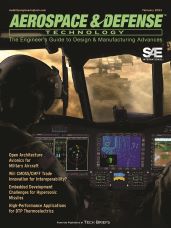Aerospace & Defense Technology
February 2023
- Using an Open Architecture Approach to Military Avionics
- Can Embedded Electronics Components Meet the Demands of Hypersonic Missiles?
- CMOSS/CMFF Trades Interoperability for Free-Thinking Innovation
- Exploring High-Performance Applications for Distributed Transport Property Thermoelectrics
- Heterogeneous Integration and SiPs Benefit SWaP-C Reduction
- The Future of Automated Guided Vehicles for Aerospace and Defense
Next-generation AGVs are already starting to deliver labor and cost savings for the U.S. defense industry, and the commercial aerospace sector is watching closely - Deep Reinforcement Learning Achieves Multifunctional Morphing Airfoil Control
Smooth camber morphing aircraft offer increased control authority and improved aerodynamic efficiency. Smart material actuators have become a popular driving force for shape changes, capable of adhering to weight and size constraints and allowing for simplicity in mechanical design. - DEVCOM ARL FY22 Industry Autonomy Technology Assessment Final Report on Security and Mobility
Forces that will conduct missions for extended periods in expeditionary situations require technologies that are mobile, robust, and have sufficient autonomy to increase team effectiveness. The U.S. Army Combat Capabilities Development Command Army Research Laboratory solicited solutions from industry that demonstrate autonomous mobility and autonomous security in operationally relevant scenarios. - Design and Analysis of a Small Unmanned Aerial System (UAS) Power Distribution System
All electrically powered autonomous vehicles possess a system that distributes power to all the vital components of the vehicle. The U.S. Army Combat Capabilities Development Command (DEVCOM) Army Research Laboratory (ARL) uses group 1 unmanned aerial systems (UASs) (weighing 20 lb) as the vehicle platform in several projects.
Related Topics:

